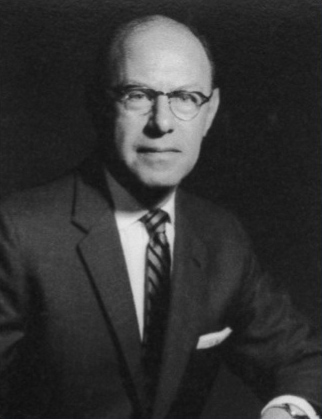
When he began his advertising agency in 1942, Paul Klemtner had none of the usual background of a pharmaceutical advertising man. He was not a pharmacist, had never “detailed” or written or designed an advertisement. His discipline was finance and from that vantage point, he was thoroughly versed in the operations of the Rx industry.
His entry into the field was through a part-time job at G.D. Searle while working his way through business school in Chicago. Eventually, he became comptroller of the firm, developing cost accounting and financial controls systems which gave him practical understanding of all aspects of a pharmaceutical company.
Klemtner anticipated the shift in direction that would change the drug industry from suppliers of generic ingredients for pharmacists to compound, to creators and marketers of patented, branded products. He became an advocate for redirecting sales forces along these lines and heightening their efficiency. He recommended the winnowing down of product lines to focus on the most profitable drugs. He also urged de-emphasizing calls on dispensing physicians to whom companies sold products in favor of concentration on pure prescribers. Companies besides Searle were in need of this kind of thinking and so Klemtner became a consultant to the industry, setting up Paul Klemtner & Company in Newark, NJ, in 1934.
As his ideas on finance and company operations proved productive, his clients turned to him for additional services, and eventually to advertising. In 1942, he began accepting advertising assignments. In 1944, he incorporated Paul Klemtner Advertising. To handle this new body of work, he brought in a knowledgeable staff beginning with Tom Jones, a recognized expert on detailing and field force management. Others were soon added—Steve Olszewski, Brad Potter, Ted Klein, Herb Freet, and Ed Funk—giving the agency creative and marketing capabilities. Just as Klemtner had had the foresight to see change in the Rx industry, he also saw the promise of improved audiovisual technology in medical communication. Early on, he experimented with closed-circuit TV in hospitals for medical education. The technology of the day proved too costly, but the exercise prepared the agency for a notable success.
In 1955, Klemtner approached Lilly, a producer of the Salk polio vaccine, with a proposal to sponsor a closed-circuit broadcast of the news conference which would announce the findings of the clinical trial on the vaccine. The company accepted the idea enthusiastically. Fifty thousand doctors in 50 cities viewed the program—probably the largest MD audience ever for an event of this kind. Building on this success, Klemtner pursued other audiovisual projects. For example, an LP record which helped Premarin maintain its leadership in the market and eventually, with improved technology, audiocassettes for a number of clients.
Paul Klemtner was a quiet, even a shy man with none of the flamboyance associated with a Medicine Ave. leader. His strength lay in his financial acumen and his accurate understanding of where the industry was headed. He also had the management talent for hiring outstanding people to take charge of areas beyond his expertise and the good sense to let them alone to do their jobs. And he appreciated their contribution to his success, setting up generous retirement and health plans for Klemtner employees. He had set a goal of retiring from business at 60, and typical of his ability to define objectives and achieve them, he did so in 1965. He sold ownership of Klemtner Advertising to the management group at the agency. He moved to Florida and enjoyed an extended retirement, passing away at 92 years of age.